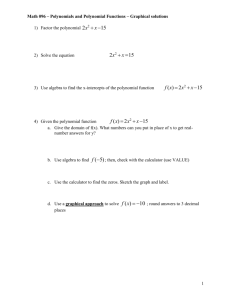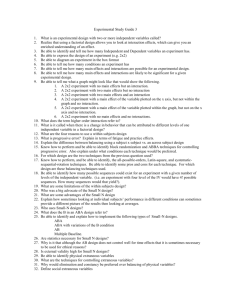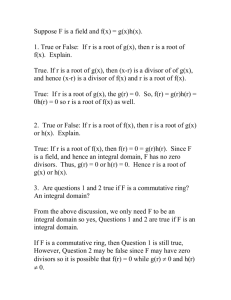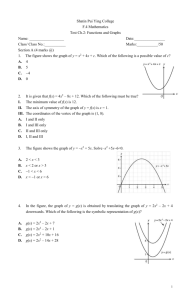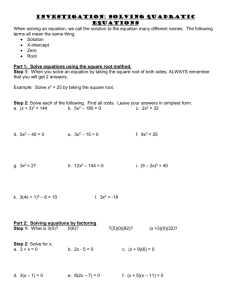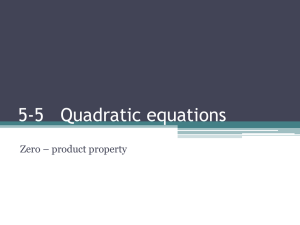question paper
advertisement
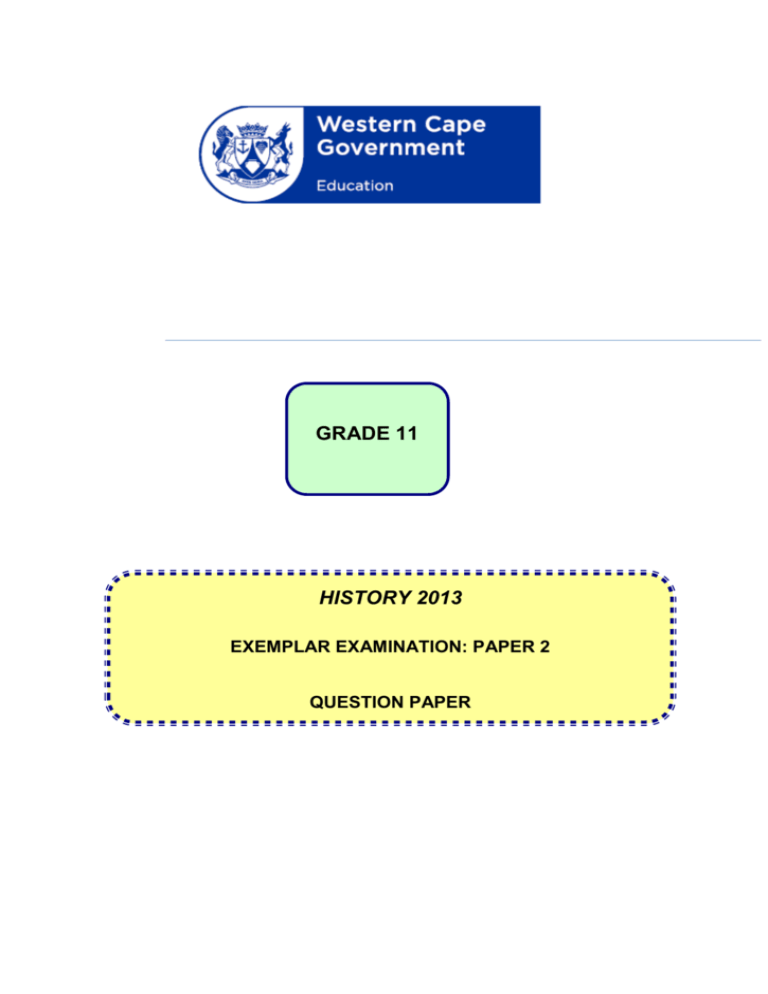
GRADE 11 GRADE 10 HISTORY 2013 EXEMPLAR EXAMINATION: PAPER 2 QUESTION PAPER GRADE 11 HISTORY – 2013 Paper 2 – Question Paper HISTORY PAPER 2 MARKS: 150 TIME: 3 HOURS Instructions and Information: 1. This question paper consists of SIX (6) questions which are as follows: SECTION A: SOURCE-BASED QUESTIONS QUESTION 1: NATIONALISMS – SOUTH AFRICAN, THE MIDDLE EAST AND AFRICA QUESTION 2: NATIONALISMS – SOUTH AFRICAN, THE MIDDLE EAST AND AFRICA QUESTION 3: I SECTION B: APARTHIED SOUTH AFRICA 1940s – 1960s QUESTION 4: NATIONALISMS – SOUTH AFRICAN, THE MIDDLE EAST AND AFRICA QUESTION 5: NATIONALISMS – SOUTH AFRICAN, THE MIDDLE EAST AND AFRICA CAPITALISM IN THE USA 1900 TO 1940 QUESTION 6: APARTHIED SOUTH AFRICA 1940s – 1960s ESSAY QUESTIONS 2. Each question counts 50 marks. 3. Learners are required to answer any THREE (3) questions, ONE (1) sourcebased question, ONE (1) essay question and ONE (1) other, either an essay or a source-based question. 4. Learners may answer two questions on the same topic. 5. When answering of questions, learners are required to demonstrate application of knowledge, skills and insight. 6. Rewriting of sources in the answering of questions will be to the disadvantage of learners. 7. Source-based questions should be answered by referring to the ADDENDUM. 8. Learners are required to write neatly and legibly. 1 GRADE 11 HISTORY – 2013 Paper 2 – Question Paper SECTION A: SOURCE – BASED QUESTIONS QUESTION 1 WHAT ROLE DID BRITAIN PLAY IN PROMOTING JEWISH AND ARAB NATIONALISM IN THE MIDDLE EAST 1914-1918? Study Sources 1A, 1B, 1C, 1D, 1E, and 1F and answer the following questions. 1.1 Refer to Sources 1A and 1B. 1.1.1 Which European power controlled most of Arabia in 1914? (1x2) (2) 1.1.2 With reference to Source 1A, explain why Britain had a strategic interest in the Middle East in 1914. (2x2) (4) 1.1.3 Extract three pieces of information from Source 1B to show why the author believes that Arabs should ‘Arise’. (3x1) (3) 1.1.4 What does the author of Arab Nationalist Manifesto (Source 1B) hope to achieve? (2x2) (4) 1.1.5 What reasons is given in Source 1C (Extract 2) to explain why The British do not support Arab claims to the shaded area of the map. (2) 1.1.6 What other reason can you infer from the information in Source 1A, which might explain why the British did not want the area to the ‘west of the Districts of Damascus, Homs, Hama and Aleppo’ to become part of an Arab state. (2) 1.1.7 With reference to Sources 1C and 1D, explain why Arab nationalists felt that Britain had betrayed them when they discovered the terms of the Sykes-Picot Agreement. (2x2) (4) 1.1.8 What do you understand by the term Zionism? (3) 1.1.9 Extract information from Source 1E to show that the Basle Declaration was a Zionist document. (2x2) (4) 2 GRADE 11 HISTORY – 2013 Paper 2 – Question Paper 1.1.10 With reference to Sources 1B and 1E, explain why Arab nationalists would have opposed the Basle Declaration. (2x2) (4) 1.1.11 Identify and explain how Jewish Zionists would have responded to the Balfour Declaration. (2x2) (4) 1.1.12 Identify and explain how Arab nationalist would have responded to the Balfour Declaration. (2x2) (4) 1.2 Use Sources 1A-1F and your knowledge. 1.2.1 What was the British policy towards the administration of Jerusalem throughout the war years? (2) 1.2.2 Write a paragraph in which you discuss the motives for and consequence of British policy in the Middle East during World War I. (8) [50] 3 GRADE 11 HISTORY – 2013 Paper 2 – Question Paper QUESTION 2 WHAT TYPES OF AFRICAN NATIONALISM HAVE EMERGED IN SOUTH AFRICA DURING THE 20TH CENTURY? Study Sources 2A, 2B, 2C, 2D, 2E and 2F and answer the following questions. 2.1 Refer to Sources 2A, 2B, 2C, 2D and 2E. 2.1.1 Extract information in Source 2A which would support the claim that in 1912 most Africans saw themselves as members of tribes or clans rather than part of an African ‘nation’. (2x2) (4) 2.1.2 Extract information from Source 2A which suggests that the SANCC wanted to work with the Union Government rather than replace or overthrow it. (2x2) (4) 2.1.3 Discuss why a critical reader would find the information given in the contextualisation of Source 2A useful when evaluating the arguments presented in Francis Meli’s book. (4) 2.1.4 Identify and explain what Source 2B suggests about ‘nationalism’ in the period after the end of World War II? (2x2) (4) 2.1.5 Explain one similarity and one difference between the type of African Nationalism imagined by SANCC in 1912 (Source 2A) and Anton Lembede of the ANC Youth League in 1946 (Source 2B). (2x2) (4) 2.1.6 Discuss Lembede’s view of African Nationalism (Source 2B) and explain Lembede’s supporters within the ANC Youth League objected to the adoption of the Freedom Charter. 2.1.7 What do you understand by the term ‘a democratic state’? (2x3) (6) (3) 2.1.8 How does the information in Source 2D help us understand why Robert Sobukhwe called his party the Pan-Africanist Congress? (2x2) (4) 4 GRADE 11 HISTORY – 2013 Paper 2 – Question Paper 2.1.9 Who, according to Robert Sobukhwe in Source 2D, was an African? (2) 2.1.10 ‘In theory at least the Congress Alliance and PAC had the same ultimate goal, but adopted different strategies to achieve this goal’ Extract and explain information in Sources 2C and 2D to substantiate this statement. (2x3) (6) 2.2 Refer to Sources 2E and 2F. 2.2.1 Extract three pieces of information from Source 2E which illustrate the type of ‘African Nationalism’ which Nelson Mandela hoped for in South Africa after 1994. (3x1) (3) 2.2.2 Use information in Sources 2E, 2F and your own knowledge to write a paragraph of approximately 60-80 works discussing how national symbols have been used to build a new ‘imagined’ South African nationalism since 1994. (6) [50] 5 GRADE 11 HISTORY – 2013 Paper 2 – Question Paper QUESTION 3 WHAT WAS THE IMPACT OF THE SHARPEVILLE MASSACRE? Study Sources 3A, 3B, 3C, 3D, 3E, 3Fand 3G and answer the following questions. 3.1 Refer to Sources 3A and 3B. 3.1.1 What does the photograph in Source 3A suggest about the impact of the Sharpeville massacre? (2x2) (4) 3.1.2 Extract evidence from Source 3B to explain why the Sharpeville massacre had such a large an impact in Europe and America. (2x2) (4) 3.1.3 What do you understand by the term ‘economic boycott’? (3) 3.1.4 Identify and explain information in Source 3B which helps us to understand why Eric Louw tried to persuade the American media to ‘tone down its remarks about South Africa’. (2x2) (4) 3.2 Refer to Sources 3C, 3D and 3E. 3.2.1 List three methods of protest, mentioned in Source 3C, which were used during the ‘freedom battles’ of the 1950s. (3x1) (3) 3.2.2 According to Mandela in Source 3C, why was it necessary for the ANC and PAC to change their political strategy after the Sharpeville massacre? (2x2) (4) 3.2.3 Contrast the opinions of Nelson Mandela (Source 3C) with those of Albert Luthuli (Source 3D), regarding the impact of the Sharpeville massacre should have on the ANC’s political strategy. (2x2) (4) 3.2.4 Does the cartoonist in Source 3E provide a reliable explanation for the founding of Umkhonto we Sizwe? Clearly explain your answer with reference to the information in Sources 3C-3E. (4) 6 GRADE 11 HISTORY – 2013 Paper 2 – Question Paper 3.3. Refer to Source 3F. 3.3.1 What does the information in Source 3F tell us about the impact of the Sharpeville massacre on government policy (3x2) (6) 3.4 Refer to Source 3G. 3.4.1 Identify the two different reactions to Constable Myubu which are revealed in Source 3G (Extract 1). (2x2) (4) 3.4.2 What does the information in Source 3G (Extract 2) tell us about impact of the Sharpeville massacre on the ordinary people who were involved and survived? (2x2) (4) 3.5. Refer to Sources 3A-3G. 3.5.1 W rite a paragraph of approximately 60-80 words in which you discuss the usefulness of oral testimonies such as the ones in Source 3G for a historian researching the impact of the Sharpeville massacre. (6) [50] 7 GRADE 11 HISTORY – 2013 Paper 2 – Question Paper SECTION B: ESSAY QUESTIONS QUESTION 4: Nationalisms – South Africa, The Middle East and Africa What role did nationalism play in mobilising the mass movement against British colonial rule which lead Ghana to independence in 1957? [50] QUESTION 5: Nationalisms – South Africa, The Middle East and Africa ‘Nationalist movements are never simply the result of a common inheritance… Afrikaner nationalism [emerged] against a backdrop of sudden urbanisation, rapid industrialisation and the growing demands of black people in the city.’ (Luli Callinicos, A place in the City’ (Cape Town, 1993) p.130) Critically discuss the accuracy of this statement with reference to the growth of Afrikaner Nationalism in the first half of the twentieth century. [50] QUESTION 6: Apartheid South Africa 1940s – 1960s The 1950s have been described as both a ‘decade of defiance’ and a ‘decade of defeat’. Critically discuss which term you consider is the more appropriate description of the struggle to end Apartheid from within South Africa. [50] 8

